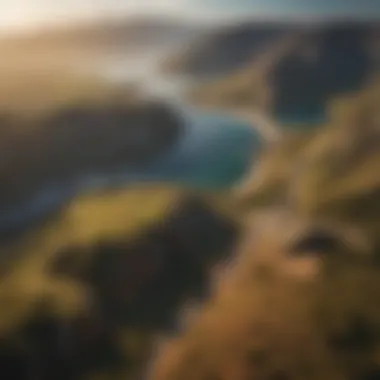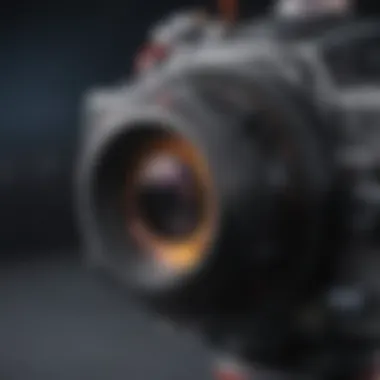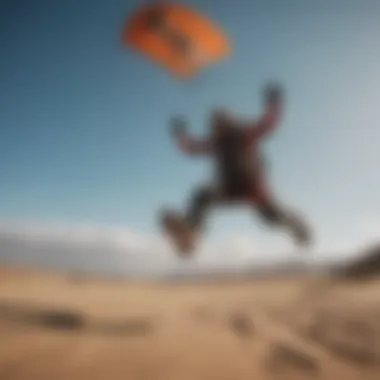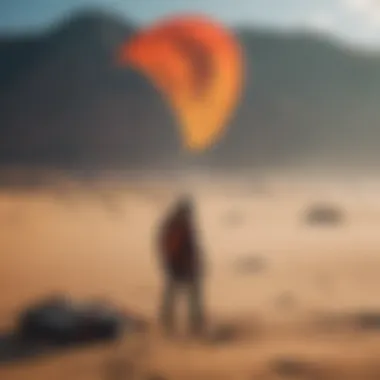Unveiling Kite Cameras: Technology and Applications


Extreme Sport Overview
Kite flying has evolved from a simple recreational activity to a dynamic component of extreme sports, often highlighted by its stunning aerial perspectives captured through kite cameras. This sport engages participants in unique ways, merging skill, creativity, and the rush of flying a kite while capturing breathtaking footage.
Preface to Kite Aerial Photography
Kite aerial photography, often referred to as KAP, employs the use of kites to elevate cameras into the sky. This method not only allows for unique and stunning images but also serves as a tool for documenting adventure sports, landscapes, and events.
Brief History of the Sport
The origins of kite photography can be traced back to the late 19th century when pioneers like George Lawrence used kites to take aerial photographs. Over the decades, technological advancements have transformed kites, enabling outdoor enthusiasts to explore and create in previously unimaginable ways.
Equipment Required
To engage in kite aerial photography, several essential pieces of equipment are necessary.
- Kite: A stable and reliable kite, such as a dual-line or single-line, is crucial for lifting a camera. Popular choices include the Peter Lynn Kites or Prism Kites.
- Camera: Lightweight cameras like the GoPro Hero or compact mirrorless cameras are preferred due to their size and durability.
- Kite Camera Rig: A custom rig or platform to securely mount the camera onto the kite line. Systems like the KAP rig help stabilize the camera.
- Remote Control: Useful for triggering the camera without having to bring it down each time.
Safety Tips and Guidelines
Engaging in kite aerial photography involves certain risks. It's important to adhere to fundamental safety measures:
- Always check local regulations regarding kite flying and airspace restrictions.
- Ensure that the chosen flying area is free of obstructions, people, and power lines.
- Use quality gear to prevent gear malfunctions that could lead to accidents.
- Maintain communication with your team if flying with others.
Relevant Statistics and Facts
With kite aerial photography growing in popularity, numerous statistics highlight its reach and impact. Recent surveys indicate that there are over 10,000 active participants globally, and the use of kite cameras in extreme sports has increased by 30% over the past five years.
Preface to Kite Cameras
Kite cameras represent a fascinating convergence of photography, technology, and the great outdoors. Understanding this topic is vital for both enthusiasts and professionals who wish to exploit aerial perspectives. Kite cameras allow users to capture images or videos from unique vantage points, often unattainable by traditional cameras. These systems enable stunning shots that show the world from above, which can enhance creativity and visual storytelling.
The benefits of kite cameras are numerous. First, they provide an economical alternative to drones; kites are generally less expensive and easier to transport. Second, they offer a quieter method for capturing images, which can be particularly useful in wildlife photography where noise can scare away subjects. Additionally, the use of kite cameras fosters an understanding of wind dynamics and spatial awareness, an important skill for extreme athletes.
However, some considerations must be addressed. Weather conditions play a significant role in kite stability and camera performance. Knowledge of kite flying techniques is essential, as is understanding the specifications and suitability of various cameras. Therefore, exploring the dimensions of kite cameras lays the foundation for both practical application and creative exploration in aerial imagery.
Definition and Overview
Kite cameras comprise a kite, a mounting system, and a camera. The kite acts as a tethered platform that lifts the camera into the air, offering a bird's-eye view of the landscape below. The mounting system securely holds the camera to the kite while ensuring maximum stability. Lastly, the camera, which can range from action cameras to DSLRs, is responsible for capturing images and videos.
Kite photography can be broadly classified into two main types: amateur and professional. Amateur kite photographers often utilize simpler kites and light cameras, while professionals may employ more sophisticated kites and advanced camera systems to obtain high-quality footage.
History of Kite Photography
The history of kite photography is rich and intriguing. It dates back to the late 19th century when pioneers like George Lawrence utilized kites for aerial photography. His work aimed to capture landscapes from aloft, a groundbreaking concept at the time. Lawrence designed specially constructed kites that could lift heavy photographic equipment, leading to stunning images of urban and natural scenes.
As technology evolved, so did kite photography. With the advent of lighter cameras and better kite designs, the practice grew more accessible. The late 20th century saw the rise of miniaturization in cameras, with models like the GoPro reshaping the landscape of aerial photography. Today, kite cameras blend traditional kite-flying skills with modern technology, making it a dynamic discipline well-suited for extreme athletes and artists alike.
Technical Components of Kite Cameras
Understanding the technical components of kite cameras is essential for anyone looking to maximize their aerial photography's potential. This section delves into crucial elements that define these systems and evaluates their benefits and considerations.
Types of Kites
Kites serve as the foundation for kite cameras, affecting how pictures are captured from the sky. Each type of kite has unique properties that influence stability, height, and wind performance.


Single-line Kites
Single-line kites are the simplest and most versatile kite types available. They can ascend quickly and are relatively easy to control, making them a popular choice for beginners.
A key characteristic of single-line kites is their lightweight structure, allowing them to reach higher altitudes with minimal effort. This makes them suitable for capturing expansive aerial shots, which is crucial in many kite camera applications.
However, their main disadvantage lies in their sensitivity to wind changes. Sudden gusts can easily destabilize the kite, and this fluctuation can lead to erratic camera movements, resulting in undesirable footage.
Box Kites
Box kites are known for their stability and unique construction, which allows for a vertical lift even in lower wind conditions. They are particularly effective in environments where wind strength varies.
The key characteristic of box kites is their rigid frame, providing additional resistance against lateral shifts in strong winds. This stability translates to more consistent imaging, which is highly desirable in filmmaking contexts.
Nevertheless, box kites can be bulkier than single-line kites, which may not be advantageous for those seeking portability.
Parafoils
Parafoils represent a more modern kite design, utilizing a soft structure that inflates with airflow. This design offers remarkable lift and maneuverability, appealing to enthusiasts who require flexibility in aerial positioning.
A standout feature of parafoils is their ability to maintain stability under various wind conditions. They can glide smoothly, achieving high altitudes effectively for clear, unobstructed shots.
However, parafoils typically need more wind to launch successfully, making them less practical in lighter breezes.
Mounting Systems
The mounting system is crucial in ensuring that the camera remains secure while providing the best possible angles for shooting. Various designs exist, from simple attachment mechanisms to advanced gimbals that allow for rotational movements. Properly utilizing the right mounting system can optimize image stability and improve the overall quality of the footage captured.
Camera Types and Specifications
Selecting the proper camera type is just as important as the kite and mount decisions. Each category of camera provides different features, affecting the end result of kite-based photography.
Action Cameras
Action cameras are compact and designed to withstand harsh conditions, making them ideal for kite photography. They are lightweight and can easily attach to various mounting systems, contributing to ease of use.
A significant characteristic of action cameras is their ability to capture high-definition video with wide viewing angles, allowing for immersive imagery from a distance. However, their smaller sensors may limit overall image quality compared to larger camera types.
Mirrorless Cameras
Mirrorless cameras combine high-performance capabilities with a compact body. They offer more versatility than action cameras, including interchangeable lenses and advanced settings for photographers.
One appealing feature is their ability to produce excellent image quality while being lighter than traditional DSLRs. However, they may require more skill and understanding of camera settings to get the best results in a kite photography scenario.
DSLRs
Digital Single-Lens Reflex cameras excel in capturing high-quality images and videos, making them suitable for serious kite photographers. Their larger sensors provide superior low-light performance and depth of field control.
The key advantage of DSLRs is their extensive range of lenses, allowing for creative flexibility in various shooting scenarios. The drawback is the weight, which can be challenging to manage when attached to a kite system, possibly affecting flight stability.
Despite their limitations, the technical components of kite cameras collectively influence the quality and success of aerial photography. Knowledge of kites, mounting systems, and camera types is fundamental to achieving desired outcomes in any kite-based filming endeavor.
Kite Camera Applications in Extreme Sports
Kite cameras have found a unique niche in the realm of extreme sports, offering unparalleled aerial perspectives that traditional cameras cannot achieve. This article aims to illuminate their significance in extreme sports, spotlighting techniques and real-world examples that showcase their capabilities. The benefits of kite cameras extend beyond mere aesthetic; they provide a lens into the dynamic and often unpredictable environments that extreme athletes navigate.
Aerial Filming Techniques


Aerial filming with kite cameras incorporates several methodologies that enhance the effectiveness of capturing action shots and breathtaking landscapes. The technique allows for stability and flexibility, crucial in high-stakes filming scenarios. Among the vital aspects, line tension plays a critical role. Adjusting the tension of the kite line can significantly influence the camera's angle and stability, leading to more dynamic shots. This adaptability is beneficial, especially in rapidly changing situations that extreme sports often entail.
Additionally, using a multi-kite setup can create unique filming angles, where more than one kite with a camera is deployed simultaneously. This approach can showcase a scene from multiple perspectives, enriching the visual storytelling of extreme sports narratives, whether it is capturing a surfer waiting for the right wave or a climber ascending a sheer rock face.
Case Studies in Extreme Sports
Skydiving
Skydiving represents a thrilling application of kite cameras, allowing for dramatic captures of the descent and the expansive views during freefall. The essential characteristic of skydiving is its high-altitude dynamics, making kite cameras a compelling choice to document jumps.
Unlike drones, which have flight limits defined by battery life, a properly deployed kite camera can remain aloft for extended periods, capturing a loop of skydives in one continuous shot. This feature provides a distinct advantage, particularly for editing sequences in post-production, showcasing pivotal moments from different angles. The aerial perspective enhances storytelling, making the visuals more engaging for viewers.
Surfing
Surfing is another sport that benefits significantly from kite cameras. The crucial aspect of capturing surfers in action lies in the proximity to the waves. Kite cameras can glide above the ocean's surface, often providing angles that offer viewers a deeper understanding of the athlete's performance and the complexities of wave dynamics.
The ability to position the camera overhead while maintaining a safe distance from the surging water bodies is a major advantage. However, care must be taken to monitor wind patterns and wave size closely. Stormy weather can affect aerial stability, potentially causing equipment issues. Still, the visual results can be stunning and worth the risk.
Rock Climbing
Rock climbing presents unique technical challenges for kite cameras but is undeniably rewarding. The most notable aspect is capturing the climber's progress against dramatic backdrops. The altitude and angle can create a sense of grandeur, emphasizing the height and difficulty of ascents.
While capturing these scenes, the use of kite cameras can highlight the isolation and focus needed by a climber. The unique feature of large-scale landscapes serves to amplify the effort and skill involved in the sport. However, the steep cliffs and variable weather conditions can add restrictions on kite mobility, making precise handling crucial.
In summary, kite cameras offer diverse applications within extreme sports, granting exceptional insights and enhancing visual storytelling. Each sport brings its nuances, requiring consideration of particular dynamics, but the potential for impressive captures remains substantial.
Advantages of Using Kite Cameras
Understanding the advantages of using kite cameras is essential for both newcomers and experienced users. Kite cameras offer unique benefits that enhance aerial photography, particularly in contexts such as extreme sports and artistic projects. These advantages stem from their distinct operational method, allowing photographers to capture breathtaking perspectives that traditional cameras often miss.
Unique Perspectives
One of the most compelling features of kite cameras is their ability to provide unique perspectives. By ascending to significant heights, these cameras can capture expansive landscapes and dynamic scenes in a way that is difficult to achieve with handheld equipment. This is particularly useful in extreme sports, where the action often occurs in rugged terrains.
The aerial viewpoint enables athletes to showcase their skills against dramatic backdrops. For instance, a surfer can be filmed riding a wave from above, producing a narrative that captures both the beauty of the ocean and the intensity of the sport. This aspect of kite cameras allows for storytelling in ways traditional ground-level photography cannot replicate.
Additionally, mounting on kites allows for smooth motions and provides stability that can be challenging in airborne shots taken from drones or helicopters. This stability enables photographers to capture crisp and detailed images, thereby enhancing the overall quality of the content.
Mobility and Flexibility
Kite cameras offer remarkable mobility and flexibility compared to other forms of aerial photography. They are relatively easy to transport and deploy, allowing users to set up quickly in various environments. The lightweight structure of the kite and camera system makes it convenient for extreme athletes who often travel to remote locations.
The flexibility of kite cameras is not just in their portability but also in their operational capability. They can be flown in various weather conditions, although, with some limitations. Depending on the design, kite types can handle wind better than others, providing users the chance to capture images in changing environments. Moreover, they can be operated without the need for extensive setup or prior knowledge, making them accessible to a broader group of enthusiasts.
In summary, kite cameras significantly enhance the way enthusiasts and professionals capture images. Their ability to provide unique perspectives combined with exceptional mobility and flexibility allows users to create visually striking content that resonates with audiences. As kite cameras evolve, their advantages are likely to facilitate even more innovative applications in sports and beyond.
Challenges and Limitations
Understanding the challenges and limitations of kite cameras is crucial for anyone interested in their use. These factors can significantly impact the quality of the footage captured and the overall effectiveness of the kite camera setup. While kite cameras offer unique advantages, they also come with certain constraints that enthusiasts should be aware of.
Weather Constraints
Weather conditions play a vital role in kite photography. For instance, high winds can lead to unpredictable flight patterns. On the other hand, low winds may not provide enough lift for the kite, making it impossible to elevate the camera. Rain and snow can damage equipment, rendering it unusable. Additionally, adverse weather can affect visibility and can make it hard to control the kite, increasing the risk of accidents.
To mitigate these issues, one should always check local weather forecasts before a session. Choosing the right time of day, such as avoiding midday sun, can improve footage quality. Furthermore, understanding the specific weather requirements for various types of kites is essential. For example, parafoils typically require stable winds, while single-line kites might be more forgiving.
Equipment Failures
Equipment reliability is another concern that must be addressed. Kite cameras often consist of delicate components that can fail at critical moments. For example, cameras may experience issues such as battery drain or malfunction due to their exposure to the elements.
Moreover, the mounting systems might not hold up under strong winds, leading to the camera detaching mid-flight. This results in lost footage and potential damage to the camera itself. Regular maintenance of equipment can help, including checking connections and ensuring all components are functioning before takeoff.
"Preparation is key. By meticulously maintaining your equipment, you can significantly reduce the likelihood of failures while flying a kite camera."


In summary, becoming familiar with these challenges and limitations is essential for a successful kite camera experience. Awareness of weather constraints and equipment reliability allows users to prepare accordingly, leading to better results in kite photography.
Safety Considerations
Safety considerations are paramount when operating kite cameras. These considerations ensure the well-being of the operator, bystanders, and the equipment itself. The unpredictable nature of wind, coupled with the inherent complexities of aerial photography, makes it crucial to implement rigorous safety measures. Being well-prepared minimizes risks and enhances the quality of the flying experience and the resulting footage.
Pre-flight Checklist
A thorough pre-flight checklist is essential for all kite camera operators. This list serves as a systematic approach to ensure everything is in order prior to launching. Key items to check include:
- Weather Conditions: Assess wind speed and direction. Ideal conditions usually feature steady winds between 5 to 15 mph.
- Kite Integrity: Inspect the kite for any signs of wear or damage. Ensure all components, including the lines and frame, are functional.
- Camera Setup: Confirm that the camera is securely mounted and functioning correctly. Check battery levels and storage capacity.
- Launch Area: Evaluate the surrounding area for obstacles such as trees, power lines, and buildings to determine a safe launch spot.
- Emergency Plan: Establish a plan for potential emergencies. This includes defining signals for indicating when to land the kite or to retrieve the camera.
Using a pre-flight checklist fosters a systematic approach to safety that can dramatically reduce the chances of accidents.
Operational Safety Best Practices
Implementing operational safety best practices is equally important during the flight. Operators should adhere to the following guidelines:
- Maintain Line of Sight: Always keep the kite and camera within your field of view. This ensures quick responses to changing conditions and minimizes the risk of collisions.
- Avoid Crowded Areas: Launch kites away from populated zones, ensuring maximum safety for onlookers and minimizing potential liability.
- Secure Equipment: Make sure that all gear is tightly secured, including cameras and any accessories mounted on the kite. Loose items can be hazardous in flight.
- Respect Local Regulations: Be aware of local laws governing kite flying and aerial photography to avoid legal issues.
- Monitor Conditions Continuously: Stay attuned to changing aerial conditions and be ready to make quick decisions if the weather deteriorates.
Following these best practices helps create a safer environment for both the operator and the public, ensuring that kite photography remains an enjoyable and productive activity.
Future Trends in Kite Camera Technology
Kite cameras represent a connection between traditional aerial photography and modern technology. The future trends in kite camera technology hold significant importance for evolution in this field. These advancements enhance not just the quality of images captured but also the overall user experience, making photography more accessible and versatile. Embracing these trends will empower both beginners and experienced kite camera enthusiasts to achieve stunning aerial views, pushing the boundaries of what is possible in kite photography.
Advancements in Drone Technology
Drone technology is constantly progressing. The developments in this arena are impacting kite cameras significantly. Recent innovations allow for lighter materials and improved aerodynamics in kite design. This means that kite cameras can operate more efficiently, capturing steady and high-resolution images from various altitudes.
Moreover, new propulsion systems are being incorporated into kites, utilizing small drone motors that increase lift without compromising stability. The improved stabilization software in drone technology also aids in reducing any necessary manual adjustments while airborne.
"The rise of compact drones has triggered the need for kite camera evolutions, creating synergies that benefit both fields."
Integration with AI
Artificial Intelligence is making a profound impact on various aspects of technology, and kite cameras are no exception. Integrating AI into these systems can automate the image capture process, enhancing user experience by reducing manual intervention. For instance, AI can analyze environmental factors, including wind speed and direction, and adjust the camera's settings accordingly.
With the implementation of AI, kite cameras can also learn from previous shooting experiences to improve future image quality. Furthermore, AI-driven editing tools might simplify post-production, allowing users to enhance their images with greater accuracy and efficiency.
- Increased focus on ease of use for beginners
- Enhanced image quality through machine learning techniques
- Smart editing tools that save time and improve results
The collaboration between kite cameras and advanced technologies shows promising growth. The blend of drone capabilities and AI functionalities highlights the evolving landscape of aerial photography, making kite cameras more intuitive and effective for all users in the coming years.
Epilogue
The conclusion serves as a crucial element in this article by summarizing the multifaceted insights surrounding kite cameras. It comes after a thorough exploration of the technology, applications, advantages, challenges, and safety considerations. This section emphasizes the relevance of kite cameras in various fields such as extreme sports and aerial filmmaking. Understanding the key components and their functionalities enables users to maximize their experiences.
Recap of Key Points
To cement knowledge, a recap of the important points discussed throughout the article is vital. First, kite cameras have a unique ability to capture dynamic footage from perspectives that are often difficult to achieve with traditional methods. They provide a budget-friendly alternative to drones while retaining some of the same aerial functionalities. Readers learned about the diverse kite types suited for specific tasks, such as single-line kites for simplicity or box kites for stability in wind. Camera choices include action cameras like GoPro, which are compact and durable, enabling high-quality imaging in various conditions.
Furthermore, the article analyzed applications in extreme sports, demonstrating how kite cameras can enhance visual storytelling. Case studies on skydiving and surfing illustrated their effectiveness in providing unique angles and perspectives.
Final Thoughts on Kite Cameras
In summary, kite cameras are not just an alternative to traditional aerial photography; they are effective tools that unleash creativity. They present opportunities for capturing breathtaking visuals that resonate with both enthusiasts and professionals. The exploration of kite camera technology reveals a landscape filled with potential.
As technology evolves, kite cameras can integrate advancements and offer even more capabilities. This may include enhanced stabilization features and advanced mounting systems. Considering these factors ensures that users remain safe and equipped for successful operations. With the right preparation, kite cameras can open avenues for discovering new ways to engage with sport and film.
"Embracing kite cameras is about breaking free from conventional limits; each flight is a chance to redefine your perspective."
The future of kite cameras, marked by integration with artificial intelligence and advancements in operation, holds promise for innovative storytelling. Thus, a discerning approach to kite cameras in filmmaking and extreme sports is essential for those looking to push boundaries and develop their craft.



